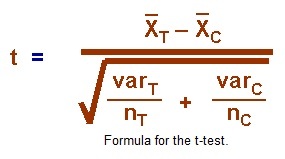Are you a statistics teacher looking for a simple example of a t-test activity that you can use in your class? Or are you a student who wants to have an idea how t-test works? I describe below an example of a situation where the t-test can be applied right after learning the procedures and understanding how it works. Read more to find out.
Teaching students through practical hands-on exercises enable them to appreciate how the different analytical tools used in research can help them address issues and problems that they encounter in their respective disciplines. I applied this teaching approach in one of my classes in graduate school. My students consisted of more than 44 graduates of different courses, namely education, biology, nursing, environmental science, public administration, mathematics, business, and tourism.
After giving them an LCD projector presentation to demonstrate an example of a t-test, a statistical tool to test differences between two groups of data, I gave them a simple situation. I asked them to find out the difference between one’s heartbeat before and after exercise.
Example of a t-test Applied in a Research Activity
Since some of my students are graduates of nursing, they are the ones who recorded the heartbeats per minute of all 44 students in every 5-member group before they exercise. After recording each of their classmates’ pulses, the whole class marched briskly in the classroom for about 5 minutes. Their heartbeats should be higher after the brisk walk in place.
I just can’t keep myself from getting amused, seeing them enjoy the activity. I can see smiles in their faces while those who can’t keep their peace laughed it all the way. I even took a picture and a video to record this momentous occasion.
Exercise to Better Health
It was 7 p.m. as classes in the graduate school are held from 5:30 to 8:30 in the evening. This activity is quite beneficial to employees of the various government and non-government institutions where these students are working. Sleepiness and tiredness of the whole workday are dispelled for the moment as they stretch their leg and face muscles.

Right after the exercise, each student recorded their heartbeats and gave them to their group leaders. The group leaders then recorded the numbers on the board for everyone to see. Everyone in the class computed for the t-test value and compared their results with those of their classmates.
Their findings showed, of course, a significant difference between heartbeats before and after exercise. But something intriguing happened. Some of the students have lower pulses after they exercised. These somehow puzzled us because, before the session, everyone rested for about 10 minutes or even more.
Discussion of the t-test Results
This finding shows that there are unexpected things that could happen in the course of doing research. And the explanation of this phenomenon requires further investigation. Why did the heartbeat decrease after exercise? Is this something worth investigating? Will we get the same results if a higher number of people are involved in the study?
In this case, I hypothesize that at the end of the day, everyone is quite stressed after work; thus, their rapid heartbeat. While doing the exercise, somehow, their muscles relaxed and caused blood flow to be much more efficient, causing their heartbeats to drop.
This phenomenon may be something that has already been discovered. A review of the literature should be done to find out. This finding could be a groundbreaking one. And computing for the t-test value may be applied to find out differences in means before and after exercise.
Pedagogical Approach that Works!
The whole activity transpired within the three-hour duration of classes each week. It consisted of a short lecture followed by the application of knowledge gained right there. The event is quite memorable and found quite effective in getting across research and statistics principles and its real-life application.
The students were able to understand and actuate their learning through practical, hands-on experience. Most of the class were able to compute for the t-test value without a fuss. An example of a t-test in a real situation works.
© 2012 October 28 P. A. Regoniel
(updated August 19, 2020)
[cite]



Interesting. Keep it up!